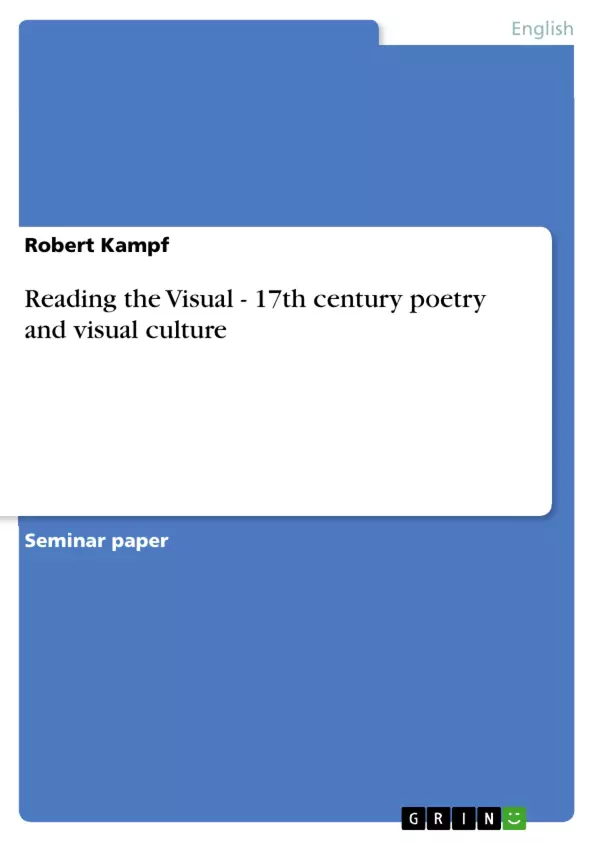One ambition of this assignment is to focus on the theory of comparing poetry and painting in terms of practices and synthesis in order to extend this theory to visual culture and its influence on artists and practices in their specific cultural context. The ambition is to show in how far an analysis of visual elements in late Renaissance culture contributes to our understanding of the cultural products of that era. To introduce the field of work I’d like to present a selection of theories connecting poetry and visual arts. Considering the enormous spectrum of visual art I’d like to focus on painting and draw a comparison to poetry. The idea is to oppose poetry and painting to find common practices and effects in order to substantiate the theory that both forms of art share common ground. The mutual influence, the shared vocabulary and language, and the similar working methods are of special interest here. In transition to late Renaissance visual culture and the work and life of John Donne, a short excursus will be necessary to have a closer look at the meaning of visuality for a culture. It is essential to our understanding of John Donne’s poetry that it is a product of society and culture as well as it is of art. Social and cultural currents in Renaissance are equally important for the process of creation as are the experiences of the individual. Based on this theoretical background I’d like to establish a connection between the self-portraits John Donne commissioned during his lifetime and the influence of contemporary painters and art collectors. The chapter will allow us a deeper insight into Donne’s affection for visual arts and image. Above that it allows us to go even further and explore the meaning of performance, staging and courtly festivals as part of the visual culture surrounding the poet. In conclusion of the preceding chapters I’d like to apply the results on the textual-level of Donne’s work. I’m going to concentrate my attention especially on elements in his poetry referring to visuality, image, picture and painting but also references to eyes, sight, seeing and imagining.
Table of Contents
- I. Introduction
- II. Ut Pictura Poesis - As Painting so is Poetry
- III. Visual Culture
- IV. John Donne - Portrait, Painting and Poetry
- V. John Donne – Reading the Visual
Objectives and Key Themes
This assignment aims to explore the role of visual culture in the work of John Donne, a prominent Metaphysical poet of the late Renaissance. It seeks to demonstrate how an analysis of visual elements can contribute to understanding the cultural products of the era, particularly in the context of Donne's life and work.
- The interconnectedness of poetry and painting as artistic forms
- The significance of visual culture in Renaissance society
- The influence of visual elements on Donne's poetry
- The role of self-portraits and other visual imagery in understanding Donne's artistic practice
- The contribution of a visual approach to interpreting 17th century poetry and culture
Chapter Summaries
- I. Introduction: This chapter introduces the central argument that visual culture played a significant role in shaping Renaissance art and culture. It argues that examining visual elements in literary works, such as poetry, can offer valuable insights into the artist's life, work, and the cultural context of their time.
- II. Ut Pictura Poesis - As Painting so is Poetry: This chapter explores the historical relationship between poetry and painting, highlighting their mutual influence and shared practices. It uses the example of Chinese and Japanese calligraphy to demonstrate how writing and drawing can merge into a single art form.
- III. Visual Culture: This chapter delves into the concept of visual culture in the context of late Renaissance society, examining the significance of images and visual representations in everyday life. It explores the various forms of visual culture, including paintings, self-portraits, and courtly festivals.
- IV. John Donne - Portrait, Painting and Poetry: This chapter focuses on John Donne's engagement with visual culture, exploring the influence of contemporary painters and art collectors on his work. It examines Donne's commissioned self-portraits and explores their significance in understanding his artistic practice.
Keywords
The main keywords and focus topics of this work include visual culture, Renaissance, John Donne, Metaphysical poetry, painting, poetry, self-portraits, imagery, and cultural analysis.
- Citation du texte
- M.A. Robert Kampf (Auteur), 2008, Reading the Visual - 17th century poetry and visual culture, Munich, GRIN Verlag, https://www.grin.com/document/149461



